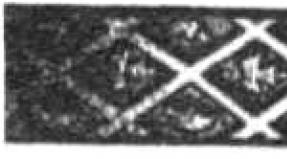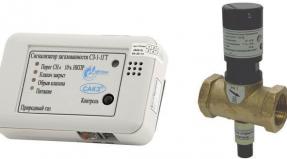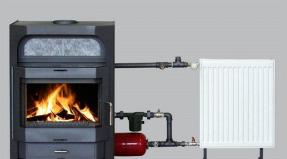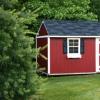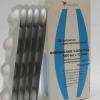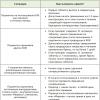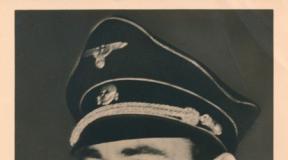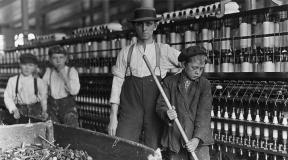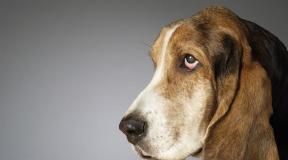Restore coins. We clean coins at home: with soap, Coca-Cola, citric acid, electrolysis method. Restoration and cleaning of coins: the starting point is the degree of preservation
One of the things that treasure hunters constantly encounter when searching is coins that have been damaged in some way.
The most common type of damage is traces from a long stay in the ground. Generally speaking, the longer a coin is in the ground, the greater the damage dealt to it. The recovery of coins here replaces cleaning, the methods of which are great. The most gentle is a simple washing of coins in warm water with soap. Sometimes a toothbrush is used - but always with a soft bristle.
A popular method of cleaning coins abroad is electrolysis or dipping in an acid solution. The main rule here is not to overdo it, otherwise the search engine runs the risk of being left without a coin, because it will no longer be possible to restore it after such global damage.

Previously, before chemicals and electrolysis, coins were cleaned the old fashioned way by placing them on a block of wood and hitting them with a wooden mallet. So most of the corrosion was removed, but, of course, in general it was not so effective. There was another heating method - to heat a coin and then lower it into ice water. Although none of these methods work well enough, it's good to know about them - what if they come in handy in an emergency?
Search engines from the United States have come up with another method for recovering coins: they use it with a glue gun, that is, melted glue is applied to a patina coin, and then the cooled and dried layer is separated from the coin. They say that this is a very gentle method for the coin.
Punctures (holes)
Another form of numismatic damage often encountered by hobbyists is punctures. This is not very beautiful and significantly reduces the value of the coins.

The reasons for coin punctures can be completely different. In Russia, for example, many nationalities make jewelry - necklaces, belts from silver coins sewn in several rows onto fabric. Naturally, holes are made in the coin for this. And since such jewelry has been made since ancient times, the coins on them can be very old. In America, coin piercings existed for a different reason: many citizens simply pierced them and sewed them into the lining of their clothes so that thieves could not steal wealth along the way. Silver quarters in the amount of 4 to 10 pieces at that time could be considered a real fortune.
When you want to repair this type of damage, you will need a torch and a fire-resistant work surface. In addition, you need silver, in sample and composition close to the metal of the coin.
Also, the standard procedure is to get the silver as close to the coin you are repairing as possible. This often means that you need to take another damaged coin from the same year to get repair material.
Then you will need to anneal the coin several times: heat it up to red, and then slowly cool it. This is necessary for a good alloying of the metal, since annealing makes the metal soft and facilitates work. But annealing must be done very carefully so as not to damage the coin in the process. Leather and wood are suitable work surfaces for this.
Next, the hole in the coin must be carefully cleaned or drilled, leaving a hole with smooth edges. The silver solder should then be cut to size as a “plug”, creating the perfect shape to cover the hole so that it can be soldered with a minimum of effort.
If everything is done correctly, then the coin will take on an almost original appearance and become a true work of art in every sense of the word.
Wrinkle (fold)
The next type of damage to a coin is a wrinkle or fold. This is mechanical damage that happens when a tractor or other agricultural machinery drives over coins from a treasure or purse.

Many of these coins are best left uncorrected because older types of coins are unlikely to be straightened without causing other damage. Although, as an exercise on different cacao and not particularly valuable money, you can try, because practice, as we know, leads to the improvement of skills. And some ancient coins can be deployed quite well.
Wrinkled or bent coins will require our burner to re-anneal. The unrolling of the coin must be done in stages so that there is only a small unrolling per annealing step. This procedure is extremely complex and, needless to say, leads to the accumulation of "fatigue" of the metal.
Carefully straighten the coin. You can use wooden bars to put pressure on the coin after annealing, for editing. Some tools that a crumpled coin repairer may need are a set of wood dowels and hammers. It's a good idea to have rubber and an eraser with you, they will come in handy in the final stages. Further, most likely, you will need a good quality magnifying glass, and even better - a magnifying device that is attached to the forehead. Some experts use far-sighted glasses, but technical equipment is always better, of course.
As a result, we can say that when repairing coins, a lot will depend on the tools, and on your abilities, and on how you use these tools. With more practice, you will become a true coin recovery expert.
Based on an article by Bill Gallagher
Today we will talk about how to clean old coins. Every year they gain even more value, but the price is highly dependent on the condition. Therefore, a properly preserved item receives additional value. When ancient coins are kept in adverse conditions, dirt, oxides and deposits of different colors occur. You can use special solutions that are sold in jewelry stores, but not everyone can afford it. Therefore, let's look at how to clean an old coin using available methods.
General information about cleaning coins
It is important to understand that not all specimens need serious cleaning, sometimes the procedure can even harm. It would also be good to learn to distinguish patina from oxide and plaque, as it gives the metal nobility and protects against external factors. Every collector knows that a layer of patina is more important than a brilliant shine.
If this is your first time trying to clean old coins at home, it's best to start with the least valuable ones. In case of failure, they will not be so sorry. On them and try out the method that interests you. When it comes time to work with elevated temperatures, try to make the transition from room to high temperature happen smoothly. A sharp drop can harm the metal.
When you have to use a brush, it is better to use a soft one, such as a toothbrush. Do not use specimens with metal bristles or emery.
It is important to dry properly, especially old coins. To do this, they need to be placed on a soft cloth and carefully applied several times on top. It happens that drops of water leave their mark on antiques.
See also video: 3 ways to clean old coins at home
Starting the cleaning process
We choose a cleaning method depending on what type of dirt we are dealing with. There are chemical and mechanical, in the second option we are talking about dirt, dust, earth and other contaminants that are cleaned mechanically without the use of special tools. The first method involves a certain chemical reaction that will help wash the coin from oxide, green plaque, or any other.
If you have not previously worked with the methods below, carefully follow the instructions and do not overdo it so as not to damage the product. And even more so, you should not change the recipe or come up with your own.
Decontamination
At this stage, we are talking about mechanical cleaning. Depending on what metal we are dealing with and how dirty it is, we choose the cleaning method:
- Soapy solution will cope with minor pollution, with its help we remove dirt with a brush or an old toothbrush.
- In difficult cases, we act depending on the composition of the coin. You can use the methods given in the paragraphs below.
- If the pattern on the surface is not visible, put it in a soapy solution for 10-15 minutes. You can use laundry soap. After that, using a toothbrush, carefully wash the coin directly in the water. Then we dry.

How to clean a coin found in the ground
Often, in search of old coins, they are found in the ground, such finds often resemble those from the USSR. Sometimes they lie there for years and the dirt is so ingrained that it has become practically one target with the product. Cleaning of such coins at home will occur by boiling.
You need to make a soda solution, for one glass a tablespoon of soda. It is better to put a contaminated item in a sieve or something else of this kind so that it does not roll at the bottom of the pan. Bring the water to a boil and let it boil for half an hour. Now turn off the heat source and let the water cool slightly. We take out the product and use a toothbrush or other soft brush to carefully clean it. We carry out the procedure so many times until the coin restores its normal appearance.
Cleaning with soda
In this case, we will clean the coins from oxidation using ordinary soda, which will be used as an alkali. That is, the main task is not mechanical cleaning, but chemical. We make a regular soda solution and immerse the products there. The concentration of the solution depends on the complexity of the case, as a rule, 1-2 tablespoons of soda are added to a glass of water. After a few hours, we pull it out, if there is still plaque, remove it with a soft cloth and dry it.
You can make a kind of gruel out of soda and water. We put coins there for a certain time and periodically look after it so that the soda does not start to dry right on the surface. After the procedure, they remove and using a soft brush clean all residues from plaque and oxide while washing in water.
You can make your own cleanser. To do this, we make a mixture of ammonia, soda and toothpaste. Having closed all this in a jar, it can be stored for a long time. Cleaning with it is very simple, apply the mixture and wash with a toothbrush.
Cleaning the coin with soap
The basic method for cleaning an old coin involves using a soapy solution. We rub the soap shavings on a grater and soak in boiling water so that a mixture of something resembling jelly is formed. We put a coin there, cover it and leave it for 1-2 days. In difficult cases, add soda, 2-5% of the total mass of the solution. Take it out when time is up. Rinse under tap water and dry. Soak in alcohol and leave to dry completely.

Digestion of coins
Vaseline or vegetable oil is heated and a coin is immersed there in a strainer for 10 minutes. Rinse with running water using soap. Clean water is poured into a vessel, immersing our coin there, heated to a boil and left to cool. After the procedure, wipe the product dry.
Jewelry cleaners
The best option for cleaning an old coin at home is a jewelry cleaner. It can be purchased at jewelry stores and workshops. It can be a napkin or a solution. In the first case, you need to wipe the surface of the product. In the second - immerse a coin there for 5 minutes.
Valuable coins are best left to professionals. It would be a pity to ruin antiques through your own incompetence. In the workshop, they will not only clean, but also polish and can apply an additional layer of protection.
Cleaning depending on the alloy
The most common coins are:
- Gold;
- Silver;
- bronze;
- Copper.
Depending on the metal, the cleaning method is determined. More details about each can be found in the relevant articles on our website.

pure gold
Coins made of gold are remarkably easy to clean. To do this, you can use one of the following methods:
- Make soapy water in a glass and add 10 drops of ammonia. Place the product there for 10-15 minutes. Wipe dry.
- To bring back the shine to gold, onion juice is a cheap and effective remedy. Using a soft cloth, rub it on the metal surface and leave it for several hours. Rinse under tap water and wipe dry.
- In stores you can buy a special paste for laundering gold.
We launder silver
Silver coins are distinguished by their durability, so it is much more difficult to damage them. It is not recommended to use soda with this metal. At first, it will cope with its task, but over time, micro-scratches may form. So how do you clean silver?
- The easiest way is with toothpaste (or powder) and a brush. Apply the product to the surface and scrub until you achieve a normal appearance.
- We make a solution of citric acid in a ratio of 1: 3. We put our collection of coins there and leave for 10 minutes. Take out and clean with a toothbrush.
- Sometimes, to restore the shine, it is enough just to immerse it in ammonia for 2 minutes.

Cleaning the Bronze
If there is no damage on the surface, oxide and any plaque, then it is processed mechanically using a soap solution. In other cases, we resort to one of the following methods.
- As in the case of silver, we make a solution of citric acid, but this time we need a 1: 2 ratio. Leave the product there for 10 minutes, rinse and wipe dry. The color may change slightly, but after a few days everything will return to its place.
- An excellent method for cleaning old gold coins is to use vegetable oil. With it, you can not only restore the appearance, but also give an additional protective layer. To do this, bring the oil to a boil and gently lower the coin there for 5 minutes. Remove and immerse in ethyl alcohol for the same amount of time. Rinse and dry.
Processing copper coins
On copper coins, not only oxide is possible, but also yellow, white, red and green plaque.
- If the coin is covered with a red layer, a solution of ammonium carbonate or 5% ammonia will help. Immerse the object for 5-10 minutes in the solution, wipe well and dry.
- The aforementioned citric acid in a ratio of 1:10 will help from green.
- Ordinary table vinegar will help from yellow plaque. Dip a coin into it for 5-10 minutes, wipe and wipe dry.
- The easiest way to wash white plaque is to take distilled water and immerse dirty copper coins in it for several days. Pull out and wipe with a soft cloth.
- In especially problematic cases, use Trilon-B.
Another way to clean copper coins in the video:
Novice collectors and the lucky ones, in whose hands were ancient copper kopecks, rubles, money, fifty dollars, altynniks or hryvnias, looking at them, think: how to clean an old copper coin? And, as it turned out, their most common mistake is an attempt to restore the shine of the coin. And this greatly reduces its market value! Indeed, in the cleaning process, the main thing is not to overdo it and not deprive the coin of a noble patina, emphasizing its antiquity! Let's try to clean the coins at home and not damage our collection.
Things to remember for a newbie
Of course, it is better if your rarities are cleaned by a professional, but it is quite possible to cope with this task yourself. To begin with, the numismatist needs to remember that the natural oxides on an ancient copper coin, which are dark brown and sometimes black, are called patina. You can't delete them! They not only add value to your rarity, but also protect it from the damaging effects of the environment. Consider the patina - if it is even, then simply wash your coin with warm water and wipe it with a soft cloth.
Citric acid will help in cleaning coins
In cases where the oxide layer is uneven and thick, it must be removed. For this, several methods are used. To get started, you should learn how to clean with citric acid, which can be purchased at any supermarket.

- Dissolve three parts of the acid in seven parts of water, thus obtaining a 30% solution.
- Dip a coin into it and wait no more than 15 minutes.
- As a result of a chemical reaction, purification will occur, and the dirt will rise to the surface.
- if the coin acquires a pinkish tint at the same time, it will change in a few weeks.
- After restoration with acid, the coin must be washed in water with soap containing alkali in order to stop the effect of acid on the metal.
Sometimes it is necessary to repeat the cleaning process for better results.
Can laundry soap be used?
Cleaning the collection can be done in another, safer way. Numismatists know very well how to clean copper coins with laundry soap. To do this, it is planed on a fine grater and a solution is prepared (ratio: 1 part of soap and 8 parts of water), stirring it thoroughly. Coins are placed in soapy water for two weeks. Periodically, water is put on fire and heated, not bringing to a boil. During this time, the dirt from the coins will begin to come off, however, sometimes (especially if the oxide layer is thick) you have to make additional efforts to clean them (for example, clean them with a soft toothbrush), but most often it is enough to wipe such a coin with a cloth.

By the way, with the help of soap, it is best to restore old and Soviet ones, issued before 1924. And more modern such cleaning can be spoiled!
How to clean copper coins from greenery and other stains
In order to rid the collection material of stains, it can be boiled over low heat in oil. A good result can be obtained using vaseline oil, as it has a rather high boiling point. Namely, it is required for successful cleaning.
Coins are kept in boiling oil for 10 minutes, do not forget to just cover the container with a lid to avoid soot. Then they are allowed to cool and washed with soap. Don't forget to dip the coin in ethyl alcohol for a few minutes to remove the grease. After this procedure, it can take its rightful place in your collection.

How to clean copper coins from oxidation
If the coin is covered with a dark cherry coating of cuprous oxide, then it can be removed by immersing the coin in a 15% ammonia solution (a 10% ammonium carbonate solution is used instead, which is less aggressive towards copper).
Dark green color indicates the presence of copper carbonate. This plaque is removed using (and how exactly, it was described above). A less aggressive way is keeping coins in kefir for 2-3 hours. Do not forget to periodically look at how the purification process is going on.
Sometimes there are also coins that are covered with a pale yellow coating of lead carbonate. This usually indicates that there is a lot of said metal in her alloy or that she has been lying with lead objects for a long time. Such plaque is well removed with a 10% solution of acetic acid.
What to do if rust appears on the coin
If you are worried about how to clean copper coins from rust, you will have to use a slow-acting reagent. This The thicker the layer of rust, the longer the coin will have to lie in the reagent.

And some numismatists advise cleaning with Coca-Cola. This method, although it seems somewhat strange, is nevertheless very effective.
Drying coins after cleaning
After you have succeeded in cleaning copper coins from dirt and oxides, they must be dried. To do this, it is best to use paper towels folded in several layers, and cover your cleaned antique with another towel on top. Use only soft ones for this - so you will not scratch the surface of the coin! By the way, you can completely dry it at a temperature of 100 ° C. And in order to prevent and slow down the oxidation process, periodically rub the collection material with a crumpled newspaper.
What to do if a copper coin has lost its noble patina?
If you still overdid it, or for some reason you had to completely clean the coin, you can restore the patina layer by artificially aging the product. True, cleaned coins themselves acquire a patina over time, but it can look uneven and this greatly spoils the appearance of the collection material. In order to avoid this, the coin is degreased and dipped for 15 seconds in a 10% hyposulfite solution, and after drying it is wiped with a soft cloth. The described operation will help to appear on the antiquity smooth and beautiful patina.

If you still don’t know how to clean copper coins in practice, then you should practice on less valuable items and only then move on to the most expensive items in your collection. In the case when the coin has become unnaturally light as a result of cleaning, put it on a sunny windowsill, where it will take on its normal appearance in a week. True, you must not forget to turn it over regularly.
If you come across a coin affected by the so-called "bronze disease", then it is better to give it to a professional restorer. You can distinguish this by oxides on its surface, similar to light green grains. And the coin itself, as a rule, is badly destroyed and crumbles if you pick it up.
A few last words
We hope that after reading the question of how to clean copper coins at home, it will not seem too difficult for you. But still I would like to warn you that especially expensive and rare specimens of your collection should be given into the hands of a specialist. Otherwise, it may turn out that your rarity is hopelessly ruined.
By the way, paste, salt, baking soda and sand are substances that can cause irreparable damage to the appearance of the collection material. After all, all these are abrasive substances that can scratch the surface of the coin and, accordingly, reduce its value.
Good luck with your restoration and collecting!
With the era of the development of the capabilities of metal detectors, treasure hunting is experiencing another heyday. On the one hand, this led to the extraction of a fairly large number of coins that were previously considered exceptional rarities. Now even 2 kopecks of 1925 or 1927 are put up for auction often enough to purchase them for the collection if funds are available. On the other hand, there are still few decently preserved copies, because almost a century of being in the ground leaves indelible marks on the coin. How to turn a black metal circle with a cherished date into something resembling a coin that will be fought for at auctions? This question brings the new owner of the rarity to the cleaning process. The same processes have to be dealt with by those who acquired a collection that was stored inappropriately.
Stage 0 - Preview
Let's say it very loud and clear right away: any cleaning will not turn her object into a "UNC" state coin. Even if there are no cavities and nicks on the coin, and the coin field begins to sparkle, the experienced eye of a collector or trader will instantly distinguish it from the native brilliance inherent in specimens that have just left the mint. The price of a polished coin is much lower than the value of its sister, found in the "Uncirculated" category ("Without Circulation"). That is why there are so many comments on the forums: "You just cleared half the value of the coin." A beautiful patina for old coins is much preferable to an unnatural sheen after hard cleaning.
If you have an expensive copy in your hands, you should not take on cleaning it without having sufficient experience. It is better to pay ten thousand to a specialist and get a coin that can start at a hundred thousand than to find a twisted piece of metal that even a beginner will not want to put in a collection. Having two coins minted from the same metal - a rare and an ordinary one - it is worth trying the cleaning method first on an ordinary coin and making sure that the cleaning did not kill the coin and did not cause significant harm to it.
At this stage, we take and put aside all the coins of the "PROOF" design and with a polished coin field. These coins are not subject to cleaning. Any impact is detrimental to them. Study the auction passages (you can use the database of our site) and you will see how the smallest defect significantly reduces the price and makes most sellers refuse to purchase a copy of less than perfect condition. If it seems to you that it is easy and simple to remove a small dark spot, then remember the parable of the monkey that was dragging peas and dropped the pea. Trying to pick it up, she dropped ten more. In an attempt to collect them, she scattered another hundred. In the same progression, defects will grow on a polished coin with the simplest cleaning. Yes, polished coins are cleaned by professionals, but that process is no longer closer to cleaning, but to restoration (which we will not touch on here).
If you still can't wait to deal with polished coins, please read the article on our site "How to launder money", dedicated to the gentle cleaning of silver in the "PROOF" category.
Step 1 - soap solution and rinse
To remove dried dirt, it is worth placing the coins to be cleaned in a soapy solution. This will soften hard foreign formations on the coin. After some time, they will either peel off by themselves, or it will be easy to remove them without damage to the coin field (which would not happen if we try to pick out a dried-up hard lump). The coins of the last century are mostly resistant to the aquatic environment, so being in a soapy solution will not harm them. Of course, you should not keep coins made of iron and other materials that quickly rust in water in water. If you want to check not in word, but in deed, pour a handful of modern dimes with a steel base into the water. Prolonged exposure to water will spoil them hopelessly. But a brass coin can be in the water element for a long time.

After being removed from the solution, the coin needs to be washed. Experts do not recommend using tap water. Due to the chloride compounds in its composition, after drying, you may find a light coating on some coins, which negatively affects the overall impression of the specimen. Therefore, get either distilled water or non-carbonated bottled water from the nearest store. Of course, if we gain experience in cleaning brass or nickel of the last years of the USSR, then we exclude unnecessary expenses, and tap water is quite suitable for them. Inexpensive coins can be cleaned in parallel with washing with a soft toothbrush with non-abrasive paste. This method removes softened dirt from hard-to-reach places.

Washing with distilled water and soap is suitable even for "PROOF" coins if you have dropped these valuable pieces in the dirt. Of course, here the toothbrush is categorically excluded. After washing, drying is necessary. Drops of water are removed with a soft cloth or napkin. Moreover, this is not rubbing, but blotting coins. That is, you only touch the surface, and do not crawl along it in all directions. After blotting, dry the coin near a heat source (for example, incandescent lamps). This does not mean that in order to save time, you should bring a coin into the area of \u200b\u200bhighest temperatures by placing it on the heater grate. From high temperatures, a valuable coin can simply crack or melt.
Stage 2 - chemistry: from cheap to expensive

Instance before cleaning


Plans and dreams of the collector * * * * * Harsh reality at the end of the process
It’s worth gaining experience on the cheapest copies, which then it’s not a pity to throw it away. At this stage, many illusions are broken. It seems that after cleaning, the coin will simply change color from black or green to original and will begin to resemble specimens resting in museum showcases. The result, most often, is something else: a corroded coin field of a disgusting appearance and a relief that is crumpled beyond recognition. And all because the patina is not a raid from the outside, but a part of the coin itself. It smooths out imperfections and hides flaws. By removing it, you will expose all hidden defects. Sometimes dry cleaning tears off almost the entire relief, which has gone into a patina from time to time, and in front of us is no longer a coin, but a strange circle on which neither numbers nor inscriptions can be made out.

Decided to clean up? Be sure to determine what metal the coin was minted from. A tool ideal for one metal will irrevocably destroy others, if you do not take into account the composition of the ingredients included in it. The most difficult thing is to clean coins made of tin or lead. These are very soft metals. For them, both abrasive cleaning, which erases the relief, and most chemistry are contraindicated. But aluminum coins are easy to clean. The film that forms on them quickly replaces the original shine with an unsightly haze. But it is easily removed with a simple composition (experts recommend 50 grams of borax, 5 grams of ammonia per 1 liter of water). After such cleaning, aluminum is not washed, but dried immediately.

Aluminum bronze and brass are easy to clean with modern kitchen chemicals. However, it should be remembered that chemistry washes out copper, and the color of a golden brass coin becomes pink or scarlet (beginners, seeing such a copy, immediately drag it to numismatists under the guise of a rare copper probe). Therefore, by experiments on cheap coins, make up your chemical series according to the degree of impact on the coin. Initially, try to rectify the state of affairs with a weaker composition, and only then proceed to strong reagents.

Copper, after parting with the patina, acquires a sharp reddish tint. Therefore, when working with copper, one must either accept the coin as such, or proceed to the next stage of the collector's basic skills - self-patina, which returns the coin to its usual chocolate color.
Stage 3 - family silver


Cleaning darkened silver does not require any additional skills. But remember that "PROOF" silver should not be cleaned in the same way as tablespoons or teaspoons left over from previous generations. Otherwise, the coin will be sold not at the price of the catalog, but at the price of the metal on the exchange. Those who work with ancient coins, in which other metals are present in addition to pure silver, have to deal with the removal of oxides. If it is copper, then the coin may turn green. Here the recommendations of experts differ, based on their own experience. Someone uses a five percent composition of sulfuric acid, and someone uses a ten percent composition of formic acid, heating it to seventy degrees Celsius. Much worse if the coin has acquired a purple-gray hue. This is the so-called "horn silver". It should be disposed of only with full confidence that there is definitely a core of healthy metal under it. A ten percent ammonia solution will help us here. After softening the gray-violet layer, it is removed with a soft cloth.
Stage 4 - gold, platinum and palladium
If the material of the coin belongs to this trinity of chemically inert metals, then the task is both simple and complex. Chemistry won't help here. Of course, with due diligence, you can get a reagent that will dissolve them, but it's better to do without it. Soap solution and rinse in water without chlorine. This is quite enough. Some seek to polish the coin before selling it. But the unnatural shine, coupled with natural scratches, is more likely to scare off potential buyers than increase their number.
Stage 5 - Specialized Fluids

A number of reputable companies have long been taking care of collectors, offering them a wide range of cleaning products that can significantly improve the appearance of the coin. In addition, there are products of small enterprises on the domestic market, which also have a positive effect on the appearance. When purchasing this or that product, you should carefully familiarize yourself with which particular metal (or group of coins) it is intended for. Calculate the economic effect of its application. After all, having bought an expensive imported product and spent it on bringing a couple of coins into a tolerable appearance, which are easy to buy for fifty at any auction, you will not receive anything but moral satisfaction. After trying a number of tools, you will also notice that cleaning them sometimes does not rid the coins of the resulting defects, but only masks them for the time being. As an example, we show a bimetallic ten.


Yes, after cleaning, dark stains no longer disturb the eyes of a potential buyer. However, a picky collector may point out that these divorces have not gone away. They are still present on the ring rim, however, in a bleached state. This is further evidence that the purge does not move coins into the "UNC" category, which is the price tag of the modern anniversary.
In the following articles, we will describe in detail how to bring an inexpensive coin into decent condition at room conditions with the help of the simplest cleaning. You will also learn about mechanical cleaning, as well as why scrapers are required. In the meantime, we hope that this short review will give you an initial idea of \u200b\u200bcleaning coins and protect you from inept actions with which you will spoil the rarity that you accidentally got.
If you have an old coin in your hands for the first time, and you are thinking about how to clean it, then this article can help you. After all, it often happens that out of inexperience, novice collectors spoil coins, trying to clean them to a shine, thereby sharply reducing their market value.
The main thing is not to overdo it!
A coin that does not contain dirt and oxides that form on the metal as a result of its corrosion does not need to be cleaned.
If the coin was found in the ground and there is a layer of dirt or clay on it, then such a coin should be washed with lukewarm water and soap, if the dirt is hard enough, you can use a soft-bristled toothbrush for cleaning.
In this way, ordinary dirt is removed from coins from any alloys.
If there are oxides, then for further proper cleaning, you need to try to determine what alloy the coin is made of.
On gold and silver coins of high standard, oxides are practically not formed. Such coins are only washed in the above way, and trying not to rub anything in particular, so as not to scratch. After washing, the coin must be dried with a soft, lint-free cloth and can be put away in the collection.
Low-carat silver coins are easiest to clean with a 9% solution of table vinegar, or use a weak solution of citric acid. The time it takes to clean the coin depends on its size, and on the amount of oxides. Usually, it is enough to leave the coin in the solution for 3-5 hours so that it cleans up well enough.
After treatment with an acidic solution, the coin must be washed with running water and soap containing alkali to stop the effect of acid on the metal.
Advice.
If you accidentally overdo it with the cleaning of the coin and it has acquired an unnaturally light shade. Leave the coin on the windowsill, on the sunny side. After a week, a beautiful uniform patina forms on the coin, the main thing is not to forget to turn it over regularly.
Cleaning copper coins
The most common and most difficult to clean are copper coins, especially if they have lain in the ground for several years. If there are no noticeable green spots on the coin, then it just needs to be washed and dried. Natural dark brown oxides, sometimes even almost black, are called patina - they cannot be removed. They represent the natural defense of the coin. The more even the color of the patina, the more beautiful the coin.
If there are dark green spots on the coin, then the coin should be cleaned with a 9% solution of table vinegar or citric acid. The cleaning time also depends on the degree of damage to the coin by oxides. After cleaning, rinse and dry the coin.
Sometimes there are coins affected by the "bronze disease". They cannot be cleaned at home, without special chemicals. Determining this disease in a coin is quite simple. Oxides are light green grains, the coin is badly destroyed, literally crumbles in the hands. If you come across such a coin, do not try to clean it yourself. If the coin is very rare, you need to contact a professional restorer.
Read also...
- Maps of the Simbirsk province Old maps of the Simbirsk province by Schubert
- We clean coins at home: with soap, Coca-Cola, citric acid, electrolysis method
- Detailed map of the Oryol region with villages, cities, towns and districts Schubert's map of the Oryol province 1850
- What are the signs advised to do if you find a cross
